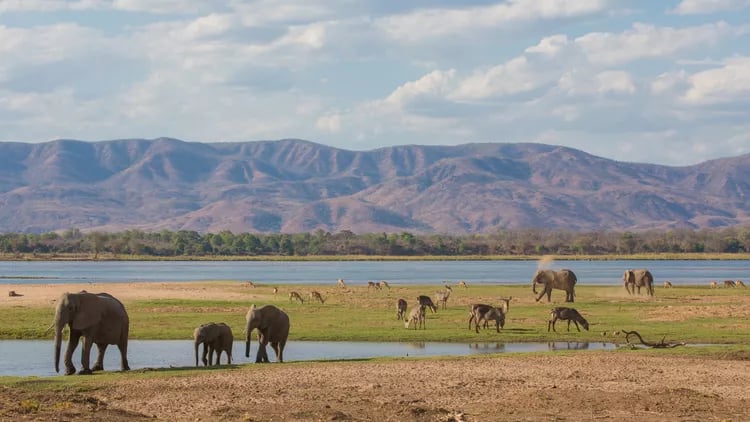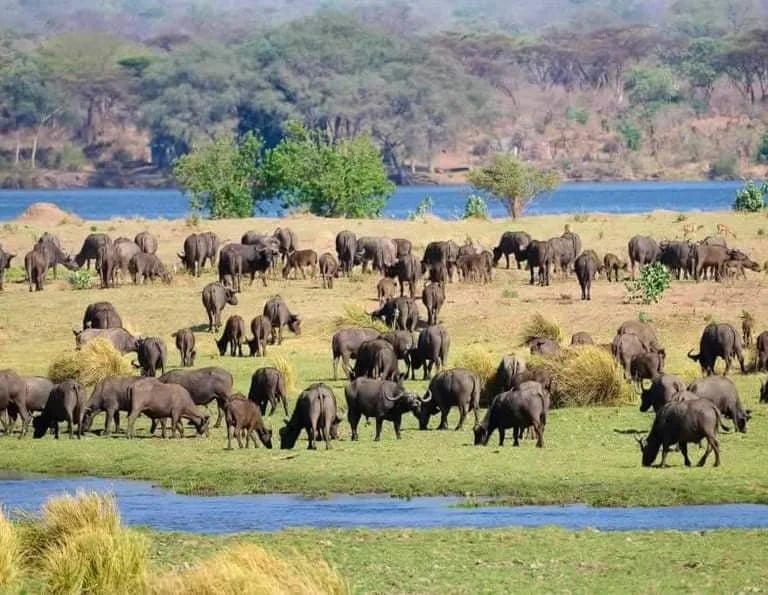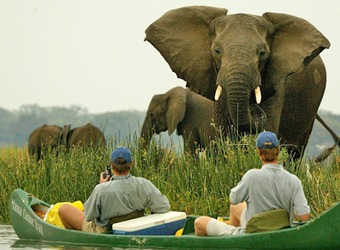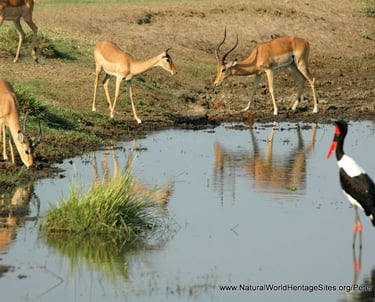Discover the Wonders of Mana Pools: A Must-Visit Tourist Destination in Zimbabwe
7/17/20255 min read


Introduction to Mana Pools
Mana Pools National Park, situated in the northern region of Zimbabwe, is renowned for its breathtaking landscapes and rich biodiversity. Established in 1963, this extraordinary park has gained its esteemed status as a UNESCO World Heritage Site due to its unique ecosystem and significant contributions to wildlife conservation. Nestled along the banks of the Zambezi River, Mana Pools encompasses an array of habitats that thrive in the fertile floodplain and surrounding woodland, creating a stunning backdrop for nature enthusiasts and adventurous travelers alike.
The park spans approximately 2,500 square kilometers and is characterized by its diverse geography, which includes large open grasslands, dense woodlands, and the iconic floodplains that are annually inundated. These elements contribute to its charm, making it a favored destination for wildlife enthusiasts and photographers seeking to capture the splendor of nature. The Zambezi River not only provides a vital water source for a multitude of wildlife species but also offers visitors opportunities for activities such as canoeing and fishing, further enhancing the park’s appeal.
One of the most remarkable aspects of Mana Pools National Park is its rich biodiversity. The park is home to a variety of wildlife, including elephants, lions, wild dogs, and substantial populations of hippos and crocodiles. Birdwatching is another highlight, with over 400 recorded bird species, attracting ornithologists and bird lovers worldwide. This abundance of wildlife, coupled with the park's serene landscapes, creates a captivating environment for those eager to witness nature's wonders.
Mana Pools National Park exemplifies the significance of preserving natural heritage and biodiversity, making it a must-visit destination. The marvels of this park promise an unforgettable experience for visitors looking to explore the transformative beauty of Zimbabwe's wilderness.
Activities and Adventures Awaiting Tourists
The breathtaking Mana Pools National Park offers an array of activities that ensure every visitor leaves with unforgettable memories. One of the most popular experiences is the guided walking safari, which allows tourists to explore the park on foot under the guidance of experienced rangers. This intimate form of wildlife observation offers a unique opportunity to encounter animals such as elephants, lions, and various antelope species in their natural habitat while gaining insights into the ecosystem.
Canoeing on the Zambezi River is another exhilarating activity that sets Mana Pools apart from other national parks. As visitors paddle along the river, they can witness the diverse wildlife that frequent its banks, including hippos and crocodiles. The tranquility of gliding quietly on the water enhances the experience, allowing for close-up encounters with animals that might be intimidated by vehicles.
Bird watching enthusiasts will find Mana Pools to be a paradise teeming with avian life. Over 400 species of birds inhabit the park, making it an ideal destination for both amateur and seasoned bird watchers. From the vibrant African Fish Eagle to the elusive Pel's Fishing Owl, these feathered wonders can be spotted throughout the park, particularly during the wet season.
For those looking to immerse themselves in nature, camping under the stars provides a memorable experience. The park offers designated campsites that allow visitors to experience the sights and sounds of the African night. Sitting around a campfire, listening to the distant roars of lions or the calls of hyenas, encapsulates the essence of Mana Pools as a truly unique destination.
The combination of these activities not only promotes adventure but also fosters a deep appreciation for the wildlife and natural beauty of Mana Pools, making it a must-visit for any nature lover.
The Ecological Importance of Mana Pools
Mana Pools National Park, a UNESCO World Heritage Site, plays a significant role in maintaining ecological balance and supporting biodiversity in Zimbabwe. The park is situated in the Zambezi Valley and is characterized by its unique combination of floodplain environments, woodlands, and riverine ecosystems. This diverse habitat fosters a vital range of species, making it a critical ecological hotspot. The floodplains serve as a breeding ground for a variety of aquatic plants, which in turn support numerous species of fish, thereby sustaining the local ecosystem.
One of the park's key ecological features is its role as a vital habitat for large mammals, including elephants, hippopotamuses, and African buffalo. Mana Pools is renowned for its elephant population, with herds often seen enjoying the lush riverine vegetation. Additionally, the park is home to a wide array of bird species, including the endangered African Fish Eagle and the strikingly colorful Lilac-breasted Roller. These avian species contribute to the park's ecological diversity and serve as indicators of environmental health.
The flora within Mana Pools is just as significant, with the extensive growth of acacia trees, mopane woodlands, and various grasses, providing essential food and shelter for both terrestrial and aquatic wildlife. The presence of these plants not only enhances the park's aesthetic appeal but also plays a crucial role in soil conservation and carbon sequestration.
Ongoing conservation efforts in Mana Pools are imperative for the protection of its unique ecosystems. Initiatives such as community engagement programs aim to raise awareness about the importance of wildlife preservation and sustainable practices. These efforts also focus on combating poaching and habitat destruction, ensuring that the park remains a thriving sanctuary for its diverse flora and fauna. By understanding and appreciating the ecological importance of Mana Pools, efforts can be strengthened to safeguard this vital natural resource for future generations.
Planning Your Visit to Mana Pools
When considering a trip to Mana Pools National Park, timing is key. The best time to visit is during the dry season, which typically spans from May to October. During these months, wildlife congregates around the dwindling water sources, providing excellent opportunities for viewing and photography. The visibility of animals is significantly enhanced, making it an ideal time for safari enthusiasts.
Reaching Mana Pools requires careful planning. The most common route is to fly into Harare, Zimbabwe’s capital, and subsequently drive or take a charter flight to the park. The drive from Harare takes approximately six hours, with the last stretch being on unpaved roads, so a 4x4 vehicle is advisable. There are also several tour operators offering packages that include transportation to Mana Pools, ensuring a smoother journey for visitors.
Accommodation options within the park cater to various preferences and budgets. Travelers can choose from luxurious lodges, like the iconic Mana Pools House, to simple campsites that immerse you in the natural environment. It is advisable to book in advance, especially during peak season, as accommodation tends to fill quickly. For those wishing for a more guided experience, consider hiring local guides who provide invaluable insights into the region’s flora and fauna, as well as enhancing safety during excursions.
Safety is paramount when exploring Mana Pools. While the park is renowned for its wildlife, it is essential to respect their space. Follow the guidance of local guides, remain in vehicles during game drives, and adhere to park regulations to ensure a safe visit. Packing essentials include lightweight clothing, a good pair of binoculars for wildlife spotting, sunblock, insect repellent, and a camera to capture the breathtaking scenery.
Overall, proper planning is integral to making the most of your visit to Mana Pools National Park, allowing you to immerse yourself in the incredible beauty and diversity of this remarkable destination.








